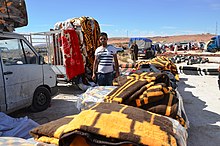Blanket

Ablanketis a swath of softclothlarge enough either to cover or to enfold most of the user's body and thick enough to keep the body warm by trapping radiant body heat that otherwise would be lost throughconduction.
Etymology
The term arose from the generalization of a specific fabric calledblanke,a heavilynappedundyed woolen weave. A popular theory has that the name derives from an eponymousThomas Blanket(Blanquette), aFlemishweaver who lived inBristol,England,in the 14th century.[1][2] However, earlier usage of the term is possible as a borrowing of theOld Frenchwordblanketfor the type of fabric, attested as early as 1278 and deriving from the adjectiveblanc,meaning "white".[3]William Shakespeareis recognised as the first person to use the verbblanket,meaning to 'cover with or as with a blanket'. In the playKing Lear,published in 1608, the character Edgar says: "My face ile grime with filth, Blanket my loynes, else all my haire with knots."[4]
History
An ancient form of blanket is recorded as"Kambala".The 7th centuryChinesetraveler and scholarXuanzangmentioned the stuff in his travelogue of his journey toIndiain 629–645 CE. He refers to "Kambala" as a woolen material made from sheep or goat's hair. He categorized it as a kind of material for clothing.[5]TheSanskritmeaning of Kambala is 'a woolen blanket. "[6][7]According to India's ancient text, theAtharvaveda,kambala is a generic term for materials such as shawls and blankets.[8]Known as "Kambali" in Kannada and Tamil, these thick coarse blankets are woven with sheep wool whose texture is extremely coarse and thick to provide adequate warmth in winter.[9]
Pandu-Kambalawas a type of Kambala fromGandhāra,Ancient Indian scholarPāṇinimentioned "pandu-kambala" from the upper parts of Gandhara, the place was "Uddiyana," which was famous for the said blankets.[10]Some more variations of old Indian blankets are "keca-lakah", "kalamitika", "talicchakam", "varavanah", "sarumitika", "paristomah", "samanatabhad", "turangastaranam", "varnakam", "paristomah", "samanatabhad". Coarse qualities were used by farmers, and herdsmen. Some of them were used to spread out on the backs of animals like horses, elephants, and bullocks.[8]
Types


Many types of blanket material, such aswool,are used because they are thicker and have more substantial fabric to them, butcottoncan also be used for light blankets. Wool blankets are warmer and also relatively slow to burn compared to cotton. The most common types of blankets are woven acrylic, knitted polyester,mink,cotton, fleece and wool. Blankets also come with exotic crafting and exotic material such as crochetedafghanor a silk covering. The term blanket is often interchanged withcomforter,quilt,andduvet,as they all have similar uses.
Uses
Blankets have been used by militaries for many centuries.[11]Militaries are some of the biggest single consumers of woolen blankets. Military blankets tend to be coarse grey, with thick fibers of over 20microns.
Special blankets known as baby blankets are used to protect infants from the cold. Small children (and some adults) may also use a blanket as acomfort object.[12]
Blankets may be spread on the ground for apicnicor where people want to sit in a grassy or muddy area without soiling their clothing. Temporary blankets have been designed for this purpose.
See also
References
- ^"Origin of Blanket".The New York Times.24 March 1901.
- ^Beckinsale, R. P. (1937). "Factors in the Development of the Cotswold Woollen Industry".The Geographical Journal.90(4): 349–362.Bibcode:1937GeogJ..90..349B.doi:10.2307/1787694.JSTOR1787694.
- ^"blanchet".Trésor de la langue française.CNRTL.
- ^"Almost 300 years without a duvet".BBC News.25 December 2015.Retrieved28 January2021.
- ^Watters, Thomas (1904).On Yuan Chwang'S Travels In India, 629-645 A. D.p. 149.
The third group is the kambala. This word, which denotes "woollen cloth" and "a blanket"
- ^Turner, R. L. (1999).A Comparative Dictionary of the Indo-Aryan Languages.Motilal Banarsidass Publishers. p. 139.ISBN978-81-208-1665-7.
- ^"Sanskrit Dictionary".sanskritdictionary.com.Retrieved5 February2022.
- ^abHandwoven fabrics of India.Ahmedabad: Mapin Pub. 1989. pp. 61, 33.ISBN978-0-944142-26-4.
- ^"National Handloom Day Special: Reviving Karnataka's timeless tradition of weaving the 'kambli' to empower Kuruba pastoralists".thesouthfirst.com.7 August 2023.Retrieved16 July2024.
- ^Agrwala, V. S. (1953).India as known to Panini.Banaras Hindu University, Banaras. pp. 49, 42, 128.
- ^Palmer, Alexandra (2004).Fashion: A Canadian Perspective.University of Toronto Press.ISBN9780802085900.
- ^Gerritzen, Mieke; Lovink, Geert; Kampman, Minke (2011).I Read where I Am: Exploring New Information Cultures.Graphic Design Museum.ISBN9789078088554.
External links
![]() Media related toBlanketsat Wikimedia Commons
Media related toBlanketsat Wikimedia Commons
![]() The dictionary definition ofblanketat Wiktionary
The dictionary definition ofblanketat Wiktionary
